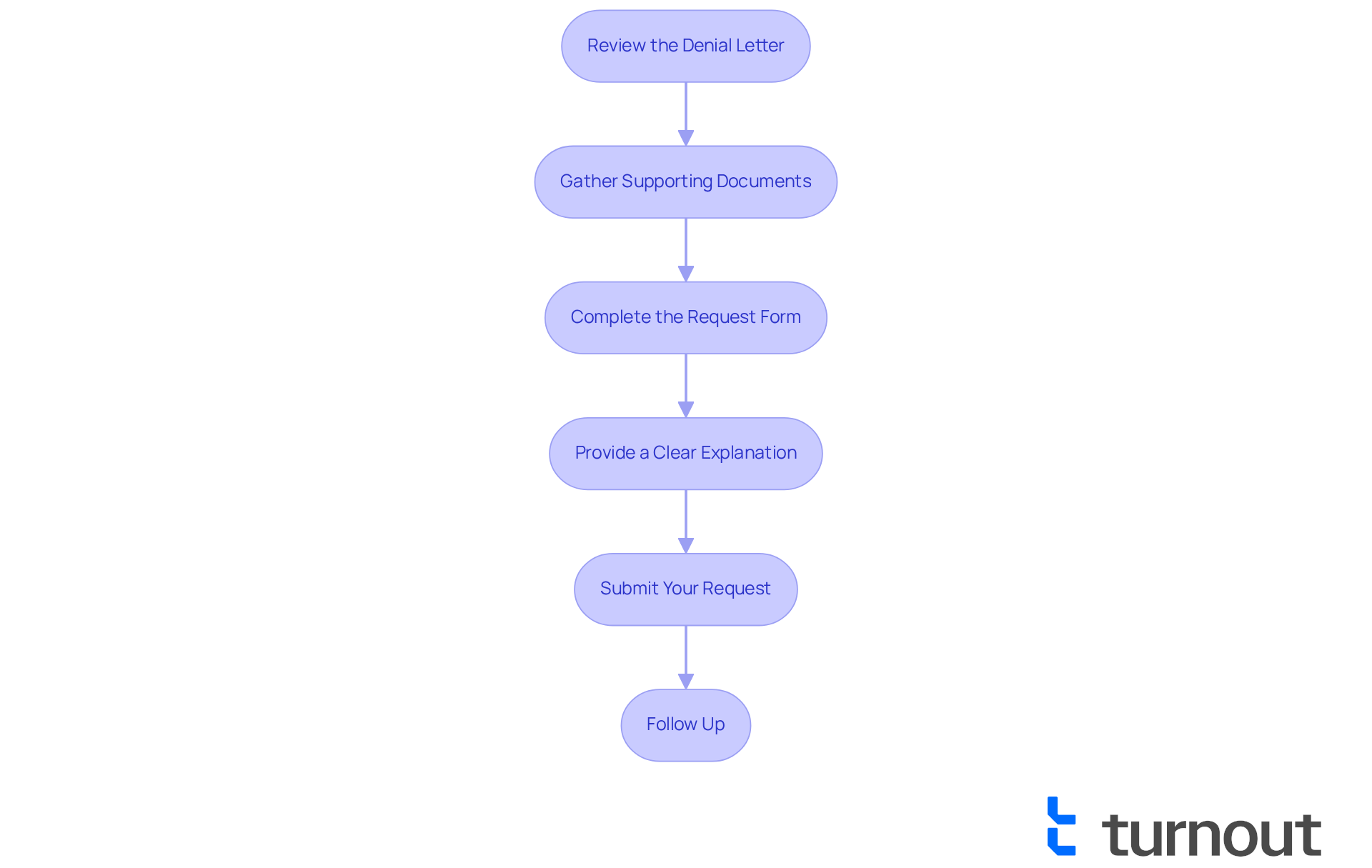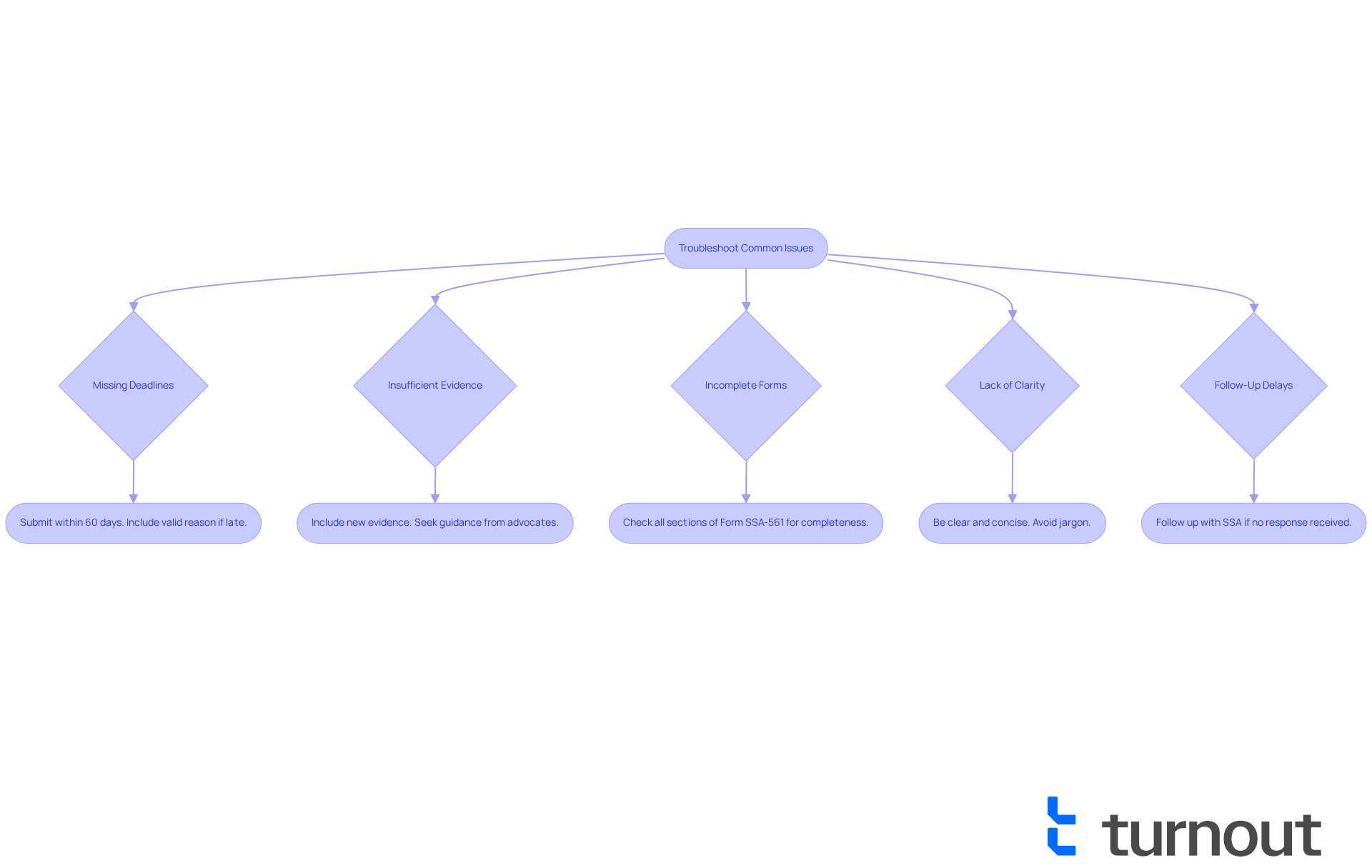Overview
Navigating the reconsideration request process for Social Security Administration (SSA) disability benefits can feel overwhelming. We understand that receiving a denial letter can be disheartening, but you are not alone in this journey. This article serves as a comprehensive guide to help you effectively navigate this process.
- Start by reviewing the denial letter carefully. Understanding the reasons behind the decision is crucial.
- Next, gather all supporting documents that can strengthen your case. Thoroughness in this step can make a significant difference.
- Completing the request form accurately is essential. Take your time to ensure that all information is correct.
- Following up with the SSA is another important step; it shows your commitment to the process. Remember, clarity in your communication can significantly enhance your chances of a favorable outcome.
We’re here to help you through this. By taking these steps, you can move forward with confidence. Together, we can work towards achieving the benefits you deserve.
Introduction
Navigating the complexities of the Social Security Administration's (SSA) reconsideration request process can feel overwhelming, especially for those facing disability claim denials. We understand that this critical step offers a chance to challenge unfavorable decisions, potentially leading to a more favorable outcome. However, it's common to encounter challenges along the way.
So, what key strategies can enhance your chances of approval? Understanding the nuances of this process is essential for anyone looking to reclaim their rightful benefits. Remember, you are not alone in this journey; we’re here to help.
Understand the Reconsideration Request Process
Navigating the review process is a crucial first step when challenging a ruling made by the Social Security Administration (SSA) regarding disability benefits. This formal reconsideration request enables individuals to seek a review of a denial or unfavorable outcome. Here’s what you need to know:
-
Definition: An appeal for review serves as a formal request to reassess a previous decision. It’s essential for anyone who feels their claim was denied due to an error or lack of sufficient evidence.
-
Eligibility: If you’ve received a notice of denial from the SSA, you can submit a reconsideration request. Remember, this application must be submitted within 60 days of receiving the denial notice.
-
Process Overview: The SSA will conduct a thorough review of your case, including any new evidence you provide. They will then offer a new determination based on this comprehensive review.
-
Potential Outcomes: The SSA may uphold the original decision, reverse it, or request additional information. Understanding these potential outcomes can help you feel more prepared for the next steps in your appeal journey.
Statistics indicate that a significant percentage of Social Security disability claims initially rejected are later accepted upon review. This highlights the importance of addressing the reasons for the initial denial with updated and thorough information. For instance, John Doe's experience illustrates how gathering extra medical documents and presenting them effectively during the review process can lead to a positive outcome.
Additionally, it's vital to stay aware of the eligibility requirements for submitting an appeal. Applicants must ensure that their earnings average less than $1,220 per month to qualify for Social Security Disability benefits, as of 2019. This understanding can greatly influence the success of your appeal.
We’re here to help you through this process, and you are not alone in this journey.

Steps to Submit Your Reconsideration Request
To successfully submit your reconsideration request, follow these steps:
-
Review the Denial Letter: We understand that receiving a denial letter can be disheartening. Carefully read the letter to grasp the reasons for the decision. This understanding will help you address specific concerns in your inquiry.
-
Gather Supporting Documents: Collect any new evidence that supports your claim. This may include medical records, treatment histories, or additional documentation that was not included in your initial application. Many successful submissions include an average of 10 to 15 supporting documents, which can significantly strengthen your case. Remember, many reconsideration requests are rejected due to insufficient new information, so thoroughness is key.
-
Complete the Request Form: Fill out Form SSA-561, the Request for Reconsideration. Ensure all sections are completed accurately to avoid delays. It’s important to remember that the first step in the SSDI appeal procedure is submitting a reconsideration request within 60 days of receiving your denial notice.
-
Provide a clear explanation in your appeal, including a detailed rationale for your reconsideration request regarding why you believe the decision should be reconsidered. Reference any new evidence and clarify how it supports your case. As one expert notes, "Think of your claim file as telling a story"—make sure your narrative is compelling and clear.
-
Submit Your Request: Send your completed form and supporting documents to the SSA. You can submit your application online, by mail, or in person at your local SSA office. It’s wise to keep copies of everything you send for your records.
-
Follow Up: After submission, monitor the status of your request. You can contact the SSA to confirm receipt and inquire about the timeline for a decision. Many applicants find that following up can help maintain their case's progress, especially since the review stage can last up to a year.
By adhering to these steps and ensuring that your submission is comprehensive and well-documented, you can enhance your chances of a favorable review. Please note that while Turnout is here to assist you in navigating this complex process, it is not a law firm, and the information provided does not constitute legal advice. We’re here to help you through this journey, providing support through trained nonlawyer advocates who understand the intricacies of SSD claims.

Troubleshoot Common Issues in Reconsideration Requests
When submitting a reconsideration request, we understand that applicants may encounter several common issues. Here’s how to troubleshoot them:
-
Missing Deadlines: It’s crucial to submit your application within the 60-day window. Missing this deadline can lead to automatic denial. If you have a valid reason for the delay, include a detailed explanation in your request to potentially mitigate the situation.
-
Insufficient Evidence: A lack of supporting documentation can result in denial. Always include new evidence that strengthens your case, such as updated medical records or statements from healthcare providers. If you're uncertain about what to include, we encourage you to seek guidance from a knowledgeable advocate. Turnout utilizes trained nonlawyer advocates who can help you identify and compile the necessary evidence. Providing clear and comprehensive documentation is vital for a successful reconsideration.
-
Incomplete Forms: Thoroughly check that all sections of Form SSA-561 are filled out completely. Incomplete forms can cause delays or denials. Review your submission carefully before sending it to ensure accuracy.
-
Lack of Clarity: Your explanation should be clear and concise. Avoid jargon and articulate straightforwardly why you believe the decision should be reconsidered. A well-structured request can significantly influence the outcome. Advocates highlight that clarity in communication can impact the reconsideration phase, and Turnout's skilled experts can assist you in creating a persuasive narrative.
-
Follow-Up Delays: If you haven’t received a response within the expected timeframe, it’s important to follow up with the SSA. Keeping an open dialogue can help accelerate the procedure and ensure your case progresses. Successful candidates frequently mention that proactive follow-ups aided in their favorable results. Turnout motivates clients to remain involved throughout the entire process.
By understanding these common pitfalls and addressing them proactively, with the support of Turnout's advocates, you can improve your chances of a successful reconsideration request. Remember, Turnout is not a law firm and does not provide legal representation, but rather offers tools and servicesto assist you in navigating the SSD claims process. You are not alone in this journey, and we’re here to help.

Conclusion
Mastering the reconsideration request process is essential for anyone seeking to challenge a denial of Social Security disability benefits. We understand that this can be a daunting task, but this structured approach not only empowers you to advocate for your rights but also increases the likelihood of a favorable outcome. Understanding the process, from the initial review of the denial letter to the submission of a comprehensive request, is crucial in navigating this often complex system.
Throughout this journey, key insights are vital. Gathering substantial supporting documentation, adhering to deadlines, and maintaining clear communication with the SSA can make a significant difference. Each step, from completing the SSA-561 form to following up on the request's status, plays a vital role in ensuring that your appeal is taken seriously. It's common to feel overwhelmed, but being aware of common pitfalls, such as insufficient evidence and incomplete forms, and knowing practical solutions to overcome these challenges can help you feel more prepared.
Ultimately, the reconsideration request process is not merely a bureaucratic hurdle; it represents a critical opportunity for you to assert your eligibility for benefits you rightfully deserve. By taking proactive steps, remaining organized, and seeking support from knowledgeable advocates, you can significantly enhance your chances of success. Embracing this journey with determination and clarity can lead to a brighter future, reinforcing the message that persistence in the face of adversity can yield positive results. Remember, you are not alone in this journey, and we're here to help you every step of the way.
Frequently Asked Questions
What is a reconsideration request in the context of Social Security Administration (SSA) disability benefits?
A reconsideration request is a formal appeal for review that allows individuals to challenge a previous decision made by the SSA regarding their disability benefits, particularly if they believe the claim was denied due to an error or insufficient evidence.
Who is eligible to submit a reconsideration request?
Individuals who have received a notice of denial from the SSA can submit a reconsideration request, provided it is done within 60 days of receiving the denial notice.
What does the reconsideration process involve?
The SSA will conduct a thorough review of the case, including any new evidence submitted by the applicant. They will then make a new determination based on this comprehensive review.
What are the potential outcomes of a reconsideration request?
The SSA may uphold the original decision, reverse it, or request additional information from the applicant.
How common is it for initially rejected Social Security disability claims to be accepted upon review?
Statistics show that a significant percentage of Social Security disability claims that are initially rejected are later accepted upon review, emphasizing the importance of addressing the reasons for the initial denial with updated and thorough information.
What should applicants keep in mind regarding eligibility requirements for Social Security Disability benefits?
Applicants must ensure that their earnings average less than $1,220 per month to qualify for Social Security Disability benefits, as of 2019. This understanding can significantly influence the success of their appeal.




